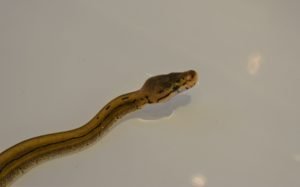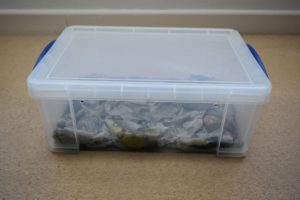Should I bathe my Ball Python? Generally, no but there are certain circumstances where it can be a good idea. Keep reading to learn more!
Of the pythons, Ball Pythons are one of the species that has the least affinity with water. Whereas Asian species like the Reticulated Python will regularly soak and forage in water, Ball Pythons do not. Nonetheless, bathing a Ball Python can help if it has had a bad shed or is constipated.
Can Ball Pythons swim?

This is a common question, as Ball Python are notorious landlubbers. Nonetheless, they are good swimmers. In fact, they are extremely good swimmers. They can make a sudden swish with their back end and take off like an eel.
There are probably two reasons for this. First is that in the wild, Ball Pythons occupy large rodent burrows and termite mounds during the day. They also tend to occupy savannah-type habitat. When they encounter water, it’s probably flooding into their hideout after a heavy rain.
In fact, flash-flooding is a serious threat to humans and animals alike in countries where Ball Pythons are native, particularly in Ghana. In this scenario, you would want to swim fast: being good at it means surviving.
The second reason is that thanks to their amphibian ancestry, most reptiles have an innate swimming ability. Phylogenists (those who study the evolutionary relationships of animals) often notice that characteristics and behaviours are handed down from ancestor to descendant species over the eons.
In a nutshell, reptiles came from amphibians, who in turn came from the water – so most reptiles can swim!
This doesn’t always hold true of course, there are exceptions like tortoises. But for squamates, that is to say snakes, lizards and amphisbaenians, it certainly does. All of them can instinctively swim, even if they never have before.
Should you soak your snake?
Whether you should soak your snake or not depends on a few factors. If, for example, you have a large, humidity-loving species like the Rainbow Boa, then you should always provide them with a water bowl big enough to soak in.
With species like this, you will notice that they soak regularly, and do not need you to regulate this behaviour. Simply put, they know what they’re doing: they just need a bowl big enough to do it.
When it comes species like the Ball Python, you should only soak and bathe them when there is an issue such as stuck shed or constipation. We’ll discuss these issues in a moment, but if your Ball Python isn’t suffering with either, then it simply does not need soaking.
Why does my snake sit in his water bowl?
What if you have a Ball Python or other terrestrial snake that is constantly soaking? This is often a sign of either a husbandry issue, or mites.
Of these, mites are the easiest issue to spot. Most species look like little black or brown dots either stuck between the snake’s scales or crawling about on top of them. They also leave droppings that look a lot like white dust. On dark snakes this can be easier to spot than the mites themselves.
Long term, mites cause a general decline in the snake’s health, and can even lead to infections with certain viruses. To get rid of them, read this article on snake parasites.
If you’ve ruled out mites, then you should focus on double-checking your husbandry. The first thing to check is of course humidity. When some snakes get too dry, they get dehydrated. To counter this, they soak in their water bow. To make sure your humidity is correct get a humidity gauge and place it (or its probe) near to floor level in the enclosure.
Another factor that can lead to constant soaking in the water bowl is temperature. If a snake is too hot it will get in some water to cool down, just like we would. To make sure the temperature is correct for your pet, I recommend buying an infrared thermometer gun.
I also recommend buying a digital thermometer and placing it under your snake’s hiding place so that you know exactly what temperature it is exposed to when trying to rest.

Bathing a Ball Python for constipation
One of the main health issues that can crop up in young Ball Pythons is constipation. Myself, I’ve had at least two babies that have suffered with this over the years, regardless of how I’ve kept them. It seems if you breed Ball Pythons, it’s just something you’ll have to deal with sooner or later.
A constipated baby Ball Python gradually looks plumper in its posterior third, slowly swelling up over two or more weeks. If left to go on for too long, the skin will even begin to show between the scales. Needless to say, this is very uncomfortable for the snake and will eventually lead it refusing to eat.
Fortunately, bathing is an excellent remedy for constipation and seems to work almost every time. If your Ball Python is looking bloated and hasn’t passed a stool or urates for over a month for an adult, or over two weeks for a hatchling, try giving it a 10 to 15 minute bath. Keep reading for details on depth and temperature.
Bathing a Ball Python for shedding
Another circumstance in which it is a good idea to bathe a Ball Python is following an incomplete shed. Sometimes, if we haven’t been quite as attentive as we should to its humidity, a snake will have a bad shed. Instead of looking nice and shiny, it looks crinkly and shabby. Again, this is really uncomfortable for the animal.
As with constipation, soaking in lukewarm water is the best solution. Given how stressed the snake will be from shedding, however, I approach it slightly differently for this scenario.
Instead of putting it in a bath to swim around, I put it in a small plastic tub, with lukewarm water for 10 to 15 minutes. Before putting the snake in, I fill the water with crumpled up newspaper and make some ventilation holes above the water level.
By leaving the Ball Python in a soaking tub like this with the lid on, you expose it to very high humidity, but it is able to rest on the newspaper without being at risk of drowning. In my experience, this works much better for shedding issues than a regular bath.

What temperature should I bathe my Ball Python?
In general, it’s best to bathe your Ball Python at a lukewarm temperature. This means 85f (29c). At this temperature, your snake will be experiencing something similar to the ambient temperature in its enclosure. If you’ve read the temperature section of my care sheet and followed it, that is!
To make sure the temperature is correct, you can use a submersible aquarium thermometer (a glass one) or an infrared thermometer gun. Make sure you check it every few minutes, especially if bathing a baby Ball Python.
Now, in the photo below, you can see that I actually made this bath at around 90f (32c). this is a little warmer than you would usually want. The only reason I did this was that the baby was snoozing in his warm hide when I got him out, and the temperature reading at that location was 90f (32c).
In this case, I matched the temperature of the bath to his probable body temperature, which he had chosen by curling up in the warm hide.

How deep should a snake bath be?
As we’ve discussed, depth isn’t an issue when using the type of soak box that I do for aiding shedding. The snake sits on the paper and is able to relax.
When bathing a snake for constipation, however, you want them to swim. The water should be deep enough for them to swim, but they should just be able to touch the bottom with the thickest part of their body. This will stop them from being afraid of drowning.
If you make the bath too deep, some snakes will go into panic mode. They’ll try to escape and get more and more agitated. This isn’t really that surprising as they could easily drown if left in a bath that is too deep.
Also on this topic:
For more on water and humidity:
Back to the water and humidity page
